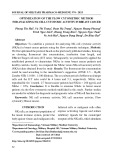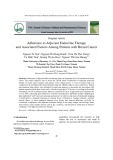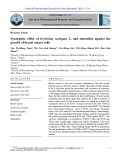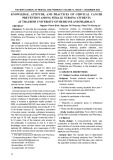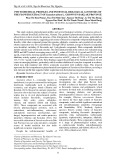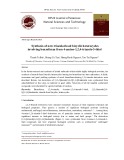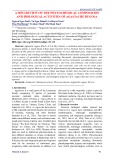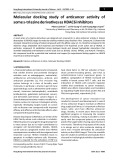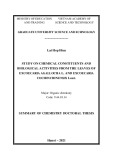doi:10.1046/j.1432-1033.2003.03379.x
Eur. J. Biochem. 270, 230–238 (2003) (cid:3) FEBS 2003
A functional polymorphism at the transcriptional initiation site in b2-glycoprotein I (apolipoprotein H) associated with reduced gene expression and lower plasma levels of b2-glycoprotein I
Haider Mehdi1, Susan Manzi2, Purnima Desai1, Qi Chen1, Cara Nestlerode1, Franklin Bontempo2, Stephen C. Strom3, Reza Zarnegar3 and M. Ilyas Kamboh1 1Department of Human Genetics, Graduate School of Public Health, 2Department of Medicine and 3Department of Pathology, University of Pittsburgh, USA
Northern blot analysis confirmed that the )1CfiA mutation was associated with lower mRNA levels and it reduced the reporter (luciferase) gene expression by twofold. Electro- phoretic gel mobility shift assay (EMSA) revealed that the )1CfiA mutation disrupts the binding for crude hepatic nuclear extracts and purified TFIID. These results suggest that the substitution of C with A at the b2GPI transcriptional initiation site is a causative mutation that affects its gene expression at the transcriptional level and ultimately b2GPI plasma levels and the occurrence of anti-phospholipid anti- bodies.
Keywords: b2-glycoprotein I; apolipoprotein H; anti-phos- pholipid antibodies; polymorphism; lupus.
Human b2-glycoprotein I (b2GPI), also known as apolipo- protein H, has been implicated in haemostasis and the pro- duction of anti-phospholipid antibodies. There is a wide range of interindividual variation in b2GPI plasma levels that is thought to be under genetic control, but its molecular basis remains unknown. To understand the genetic basis of b2GPI variation, we analyzed the 5¢ flanking region of the b2GPI gene for mutation detection by DHPLC and identi- fied a point mutation at the transcriptional initiation site ()1CfiA) with a carrier frequency of 12.1%. The mutation was associated with significantly lower b2GPI plasma levels (P < 0.0001) and low occurrence of anti-phospholipid antibodies in lupus patients (4.8% antibody-positive group vs. 16.6% in the antibody-negative group; P ¼ 0.019).
Human b2-glycoprotein I (b2GPI), also known as apolipo- is a plasma glycoprotein of approximately protein H, 50 kDa [1], which is primarily expressed in liver and is associated with very low-density lipoproteins, high-density lipoproteins, and chylomicrons and it also exists in lipid-free form in plasma [2,3]. The gene organization of b2GPI has been characterized, which consists of eight exons, spanning 18 kb on chromosome 17q23–24 [4]. b2GPI is a single chain polypeptide of 326 amino acids [5–8] that shows extensive internal homology within its five consecutive homologous segments of approximately 60 amino acid each. These segments are referred to variously as GP-I domains [9], sushi domains [10], short consensus repeats (SCR) or complement control protein (CCP) repeats [5,11,12].
b2GPI has been implicated in a variety of physiological pathways, including blood coagulation, haemostasis and the production of anti-phospholipid antibodies (APA).
b2GPI inhibits the contact activation of the intrinsic pathway by binding to and neutralizing negatively charged macromolecules that might enter the blood stream and therefore diminishes inappropriate activation of the blood coagulation pathway [13–16]. In in vitro studies, b2GPI- deficient plasma is unable to inhibit the contact activation of blood coagulation [17] and therefore raises the possi- bility that persons deficient in b2GPI may be more susceptible to thrombosis. However, the role of b2GPI- deficiency in thrombosis is controversial [18–20]. Recently, b2GPI has become the subject of extensive study because of its central role in the production of APA in sera of patients with primary anti-phospholipid syndrome and lupus. Originally, it was thought that APA in sera are produced against simple anionic phospholipid molecules, however, subsequent data showed that APA are produced against a complex antigen consisting of both b2GPI and anionic phospholipid [21–25].
There is a wide range of interindividual variation in b2GPI plasma levels, ranging from immunologically undetectable to as high as 35 mgÆdL)1, with a mean value of 20 mgÆdL)1 in white people and 15 mgÆdL)1 in black people [26–29]. Based on family data, two autosomal codominant alleles b2GPI*N (normal) and b2GPI*D (deficient), have been proposed to control the expression of three quantitative phenotypes, NN (normal), ND (intermediate) and DD (deficient). Homozy- gous NN individuals have a b2GPI plasma concentration between 16 and 35 mgÆdL)1, heterozygous ND individuals between 6 and 15 mgÆdL)1, and individuals having values less than 6 mgÆdL)1 are classified as DD homozygotes.
Correspondence to H. Mehdi or M. I. Kamboh, Department of Human Genetics, Graduate School of Public Health, University of Pittsburgh, Pittsburgh, PA 15261, USA. Fax: + 1 412 383 7844, Tel.: + 1 412 383 7193, E-mail: haider.mehdi@mail.hgen.pitt.edu or ilyas.kamboh@mail. hgen.pitt.edu Abbreviations: b2GPI, b2-glycoprotein I; APA, anti-phospholipid antibodies; EMSA, electrophoretic gel mobility shift assay; Luc, luciferase; DHPLC, denaturing high performance liquid chromatography. (Received 26 July 2002, accepted 20 November 2002)
(cid:3) FEBS 2003
Functional polymorphism in b2GPI (Eur. J. Biochem. 270) 231
control, but
its molecular basis
the Cys306Gly
the promoter
region,
conditions using AmpliTaq Gold DNA polymerase (Applied Biosystems, Foster City, CA, USA) mixed with 9 : 1 ratio of PfuTurbo DNA polymerase (Stratagene, La Jolla, CA, USA) to eliminate the possibility of PCR- induced mutations. The reactions were then denatured at 95 (cid:4)C for 4 min and gradually reannealed by decreasing the temperature to 25 (cid:4)C over a period of 45 min, which allowed the PCR-amplified DNA to form hetero- and homo-duplexes. The PCR products were then analyzed on the WAVETM DNA Fragment Analysis System (Transgenomic Inc., San Jose, CA, USA) using a linear acetonitrile gradient. The melting temperature (Tm) and acetonitrile gradient were determined by the size and GC content of the DNA fragments using WAVEMAKER 4.0 software (Transgenomic Inc., San Jose, CA, USA). The optimal mutation detection conditions were standardized by analyzing the elution profiles of the PCR fragments at temperatures, Tm +2 and )2, and the eluted fragments were detected by a UV detector. The PCR products showing the DHPLC variant patterns were then sub- cloned into a pCR II-TOPO cloning vector (Invitrogen, Carlsbad, CA, USA) using the supplier’s standard procedure. The positive clones with a full-length DNA insert were subjected to DNA sequencing using Thermo Sequenase Cy 5.5 Terminator Cycle Sequencing kit (Amersham Pharmacia Biotech Inc., Piscataway, NJ, USA). The sequencing reactions were then analyzed by OpenGene Automatic DNA Sequencer System (Visible Genetics, Suwanee, GA, USA) for mutation detection.
The variation in b2GPI plasma levels is thought to be under genetic is unknown. Therefore, it is critical to delineate the genetic determinants of b2GPI variation. In our genetic associ- ation studies of population-based [30] and lupus patient [31] samples, we have shown that two polymorphisms in the b2GPI gene, Cys306Gly and Trp316Ser, independ- ently affect variation in b2GPI plasma levels. However, our in vitro mutagenesis and expression studies revealed that these mutations were not associated with altered expression or secretion of recombinant b2GPI (rb2GPI) [32]. We hypothesized and that Trp316Ser mutations are in linkage disequilibrium with two different functional mutations. There are three main plausible regions in which mutations can directly affect plasma protein levels: splice junctions and the coding region. In our extensive survey of the coding region and the intron–exon boundaries, we have not found causative mutations, other than the Cys306Gly and Trp316Ser. We therefore hypothesized that the 5¢ flanking region of b2GPI harbors functional mutations that determine the interindividual variation in b2GPI plasma levels. Here we report the existence of a mutation at position )1 (CfiA) in the 5¢ flanking region of b2GPI, which is in linkage disequilibrium with the Trp316Ser mutation and is associated with significantly lower b2GPI plasma and mRNA levels and the low occurrence of APA. Furthermore, this mutation reduces the expression of the luciferase (Luc) reporter gene by twofold and disrupts the binding of nuclear trans-acting factors.
Genotyping for the -1C(cid:1)A mutation
Experimental procedures
tissues using the QIAamp Blood kit
Human subjects
The genomic DNA was isolated from buffy coats and (Qiagen, liver Valencia, CA, USA). Genotyping for the )1CfiA muta- tion was performed by using a forward mismatch primer starting at nucleotide )22 (5¢-GTCTTTTTAGCAGACG AAAGC-3¢; the mismatch base is underlined), which creates the CviJ1 restriction site at nucleotide )1, in combination with a reverse primer as described above to PCR-amplify the genomic DNA. The amplified fragment of 96 bp was digested with CviJ1 (Molecular Biology Resources, Milwaukee, WI, USA) at 37 (cid:4)C overnight followed by electrophoresis on 6% (w/v) polyacrylamide gel. The homozygous wild type (CC) yielded two fragments of 22 bp and 74 bp, while the homozygous mutant type (AA) remained uncut (96 bp).
Northern blotting
For mutation detection, seven individuals with low b2GPI plasma levels, ranging from 0.2 mgÆdL)1 to 5.4 mgÆdL)1, from our two previous studies [30,31], were subjected to denaturing high performance liquid chromatography (DHPLC) and DNA sequencing. For association with the new mutation, we used 232 lupus women (mean age 45.11 ± 11.28 years) in which we have previously reported b2GPI plasma levels, APA (anticardiolipin and lupus anticoagulant), anti-b2GPI and b2GPI codons 306 and codon 316 genotypes [31]. Normal human liver tissues (n ¼ 50) were obtained from the NIH-funded program: Liver Tissue Procurement and Distribution System (LTPADS) at the University of Pittsburgh. The study was approved by the Institutional Review Board.
Mutation detection by denaturing high performance liquid chromatography (DHPLC) and DNA sequencing
The mutation detection in the 5¢ flanking region of the b2GPI gene in seven selected subjects with lower b2GPI plasma levels was performed by DHPLC. Briefly, a set of PCR primers between nucleotides )132 and +74 (forward: 5¢-GAATGTGGGTCTCAGAGTTCC-3¢ and reverse: 5¢-GGCAGAGAAAACTCGAGAAC-3¢) were designed to generate a 206 bp 5¢ flanking DNA fragment. For DHPLC analysis, PCR was performed under oil-free
Total RNA was isolated from human liver tissues using TRIZol solution (Gibco/BRL/Life Technologies, Inc., Rockville, MD, USA) according to the manufacturer’s instructions. Total RNA concentrations were determined by measuring the optical density at 260 nm. Northern blots were prepared by separating 10 lg of total RNA on formaldehyde containing 1% (w/v) agarose gels and transferring them to Zeta probe membranes (Bio-Rad Laboratories, Hercules, CA, USA). Blots were hybridized with 32P-labeled cDNA probes for b2GPI as described elsewhere [6] or GAPDH using the manufacturer’s protocol (Ambion, Inc., Austin, TX, USA).
232 H. Mehdi et al. (Eur. J. Biochem. 270)
(cid:3) FEBS 2003
b2GPI quantification
elsewhere [33]. Actual Luc activity was calculated as the ratio of firefly to Renila Luc activity for each experiment.
Preparation of nuclear extracts and electrophoretic gel mobility shift assay (EMSA)
Liver tissues were homogenized in radioimmunoprecipita- tion buffer [20 mM Tris/HCl, pH 7.5, 0.15 mM NaCl, 2 mM EDTA, 1% (w/v) sodium deoxycholate, 1% (v/v) Triton X-100, 0.1% (w/v) SDS] containing 1 mM phenyl- methanesulfonyl fluoride followed by centrifugation at 1500 g for 15 min to remove the cellular debris. b2GPI levels were measured by capture ELISA after diluting the lysates (50, 100 and 200-fold) in NaCl/Pi (0.137 M NaCl, 2.7 mM KCl, 4.3 mM Na2HPO4.7H2O, 1.4 mM KH2PO4, pH 7.3) containing 1% (w/v) bovine serum albumin as described elsewhere [30,31]. Total protein in liver lysates was measured using the Bio-Rad Protein Assay Kit (Bio-Rad Laboratories, Hercules, CA, USA) according to the manufacturer’s instructions. Bovine serum albumin was used as standard to determine the protein concentrations in the liver lysates.
Plasmid DNA constructs
The nuclear extracts from mouse liver tissues were prepared as reported earlier [35,36]. Purified TFIID was purchased from Santa Cruz Biotechnology, Inc. (Santa Cruz, CA, USA). The double-stranded wild ()1C) and mutant ()1A) type oligonucleotides were labeled with [a32P] dCTP (3000 CiÆmmol)1) (NEN, Boston, MA, USA) by filling in and blunt ending with Klenow enzyme (Gibco BRL/Life Technologies, Inc., Rockville, MD, USA). The labeled probes were then gel purified and used in EMSA, as described earlier [35,36]. Two micrograms of poly(dI-dC) (Amersham Pharmacia Biotech, Piscataway, NJ, USA) were used as the nonspecific competitor in the binding reactions that were carried out at room temperature for 20 min before loading onto 5% nondenaturing polyacryl- amide (19 : 1 acrylamide/bis acrylamide) gels. Gels were run in 0.5· TBE buffer (45 mM Trisborate and 1 mM EDTA) at a constant voltage of 190 V, then dried and autoradio- graphed using intensifying screens. The concentration of nuclear protein extracts used in each reaction was 2 lg and that of the labeled probe was between 0.2 and 0.4 ng.
Statistical analysis
The 5¢ flanking region of genomic DNA containing a 696-bp long DNA fragment (from nucleotide )622 to +74) from heterozygous subjects (CA genotype) was PCR amplified using a forward primer starting at nucleotide )622 (5¢-CCAAGACATACTAAGAATGG-3¢) and the same reverse primer ending at nucleotide +74 (5¢-GGCA GAGAAAACTCGAGAAC-3¢) as described above. The 696 bp long PCR amplified fragment ()1C or )1A allele) was then ligated to the pCR II-TOPO cloning vector (Invitrogen, Carlsbad, CA, USA) using the supplier’s standard procedure. For PCR amplification, we used Pfu DNA polymerase (Strategene, La Jolla, CA, USA) to reduce the chances of PCR induced mutation followed by five minute extension with AmpliTaq Gold DNA polymerase (Applied Biosystems, Foster City, CA, USA) to facilitate TA cloning into the pCR II-TOPO vector. The size of the DNA insert and fidelity of DNA polymerase was confirmed by restriction analysis and DNA sequencing. The wild ()1C) and mutant ()1A) type fragments were then inserted upstream of the firefly Luc reporter gene into the promoter- less pGL3-basic vector (Promega, Madison, WI, USA) using appropriate restriction enzymes followed by ligation with T4DNA ligase (New England Biolabs, Inc., Beverly, MA, USA), as described elsewhere [33]. The positive clones with the full-length wild ()1C) and mutant ()1A) type fragments were identified by restriction analysis and DNA sequencing.
Allele frequencies were calculated by allele counting. Hardy–Weinberg equilibrium was tested by a v2 good- ness-of-fit test. One-way ANOVA was used to test for mean b2GPI levels among different genotype groups adjusted by age. Pair-wise measure of linkage disequilibrium between markers in the b2GPI gene was estimated by ID’I calcula- tion [37]. Comparison of genotype and allele frequencies between antibody positive and antibody negative groups was made by 2 · 2 v2 test and Z-test, respectively. The b2GPI concentration in liver samples was calculated as lg b2GPIÆmg)1 total liver protein where average optical density of the mixture of 11 samples is taken as standard for b2GPI concentration (5 lg b2GPIÆmg)1 total liver protein). The luciferase activity of each construct was calculated as a mean ± SD value of three experiments in triplicate after adjusting the transfection efficiency by normalizing them with the Rluc control value.
Results
Identification of the -1C(cid:1)A mutation
Transient transfection and dual-luciferase assay The wild ()1C) and mutant ()1A) type chimeric-firefly Luc constructs (4 lg) were used to transiently cotransfect COS-1 cells along with Renila Luc control vector (pRL-CMV) (1 lg) (Promega, Madison, WI, USA) using the DEAE- dextran method as described earlier [34]. The transfection control dish (mock transfected) received only DEAE- dextran, but no-DNA and Luc-control dishes received only pGL3-basic or pRL-CMV vector. After 48 h of transfection, cells were washed twice with NaCl/Pi and lysed in the lysis buffer (Promega, Madison, WI, USA) followed by meas- urement of Luc activity by TD-20/20 Luminometer (Turner Design, Sunnyvale, CA, USA) using the dual luciferase assay system (Promega, Madison, WI, USA), as described
To enhance the likelihood of identifying functional muta- tions associated with b2GPI-deficiency, DNA samples from seven individuals previously identified with low b2GPI plasma levels, ranging from 0.2 mgÆdL)1 to 5.4 mgÆdL)1 [30,31] were screened by DHPLC for mutation detection in the 5¢ flanking region of the b2GPI gene between nucleo- tides )132 and +74. A point mutation was identified at position )1 (CfiA) (Fig. 1A,B), which affects the consensus sequence for transcriptional initiation site and TFIID (Fig. 2A). Five of the seven samples with low b2GPI plasma levels (3.4, 3.7, 4.3, 5.2 and 5.4 mgÆdL)1) had the )1CfiA
(cid:3) FEBS 2003
Functional polymorphism in b2GPI (Eur. J. Biochem. 270) 233
the effect of
Cys306Gly genotypes. All three polymorphisms were signi- ficantly associated with b2GPI plasma levels (P < 0.0001). In all cases the less common genotypes were associated with lower levels as compared to the homozygous wild type genotypes and the effect was gene-dosage related. When all polymorphisms were included in the regression model, the significant effect of the Trp316Ser polymorphism was lost (P ¼ 0.29), but it remained significant for the )1CfiA (P ¼ 0.035) and Cys306Gly (P < 0.001) polymorphisms. This confirms our hypothesis that the Trp316Ser polymorphism was due to its non-random association with the )1CfiA mutation and that the effect of the Cys306Gly is independent, which is perhaps mediated by a yet to be discovered mutation.
Impact of the )1CfiA mutation on the occurrence of anti-phospholipid antibodies (APA)
mutation (CA genotype, Fig. 1C) and they were also heterozygous for the Trp316Ser mutation. Of the remaining two subjects, one with b2GPI plasma levels 0.2 mgÆdL)1 was homozygous for the Cys306Gly mutation and the other with b2GPI plasma levels 0.8 mgÆdL)1 was wild type at all three sites. We subsequently genotyped 232 subjects for the )1CfiA mutation, and its distribution stratified by the Cys306Gly and Trp316Ser polymorphisms is presented in Table 1. The distribution of all polymorphisms was in the Hardy–Weinberg equilibrium. The frequency of the )1A allele was 0.0625 with a carrier frequency of 12.1%. The carrier frequencies of the Gly306 and Ser316 alleles were 7.1% and 9.1%, respectively. There was a nearly complete linkage disequilibrium between the )1CfiA and Trp316Ser sites (P < 0.0001). Of the 21 individuals with the Trp316Ser mutation, 20 had the )1CfiA mutation. On the other hand, of the 16 individuals with the Cys306Gly mutation, only one had the )1CfiA mutation, strongly indicating that these two sites are in linkage equilibrium, as also reflected in the pair-wise measure of linkage disequilibrium (Table 2).
Impact of the -1C(cid:1)A mutation on b2GPI plasma levels
Table 3 presents the age-adjusted b2GPI plasma levels among the )1CfiA genotype along with the Trp316Ser and
Previously we have reported the association of the Trp316Ser polymorphism with the occurrence of APA (anticardiolipin or lupus anticoagulant), but not with anti- b2GPI in this sample [31]. As the Trp316Ser polymorphism is tightly linked to the )1CfiA mutation, we predicted a similar association with the )1CfiA mutation. As expected, no association was observed between )1CfiA and anti- b2GPI (data not shown). However, both )1CfiA and
Fig. 1. Identification of the -1C(cid:1)A mutation. (A) DHPLC profile of the )1CfiA mutation where the heterozygous PCR fragments were separated into two peaks (retention times 5.05 and 5.32) while the wild type PCR frag- ment gave a single peak (retention time 5.30). (B) Sequence differences between wild type ()1C) and mutant type ()1A) alleles. (C) Genotyping for the )1CfiA mutation where CviJI restriction pattern of homozygous wild type (CC, 74 bp), homozygous mutant type (AA, 96 bp), and heterozygous type (CA, 96 bp and 74 bp), were separated on 6% polyacrylamide gel.
234 H. Mehdi et al. (Eur. J. Biochem. 270)
(cid:3) FEBS 2003
Table 2. Pair-wise measure of linkage disequilibrium between b2GPI polymorphisms.
Pair-wise comparison P-value*
Nucleotide )1 vs. codon 316 Nucleotide )1 vs. codon 306 codon 316 vs. codon 306 < 0.0001 0.294 0.368
*P-values were obtained by v2–tests.
Table 3. Mean b2GPI plasma levels among b2GPI genotypes.
P-value Polymorphic site/genotype b2GPI levels (mgÆdL)1)
)1CfiA
18.45 ± 3.90 14.21 ± 4.22 9.40 < 0.0001 CC (n ¼ 204) CA (n ¼ 27) AA (n ¼ 1)
Trp316Ser
18.39 ± 3.88 13.37 ± 4.33 9.40 < 0.0001 Trp/Trp (n ¼ 211) Trp/Ser (n ¼ 20) Ser/Ser (n ¼ 1)
Cys306Gly
18.41 ± 3.54 10.49 ± 2.56 0.20 < 0.0001 Cys/Cys (n ¼ 210) Cys/Gly (n ¼ 15) Gly/Gly (n ¼ 1)
Fig. 2. Partial 5¢ flanking region of the b2GPI gene and EMSA probes. (A) A partial 5¢ flanking sequence of human b2GPI (in lower case) showing the transcriptional initiation site (nucleotide + 1; arrow) as well as portion of exon 1 (upper case) including the 5¢ untranslated region (UTR) upstream of the translation start site (ATG, nucleo- tide +32) and a TFIID consensus sequence (underlined) [4]. A partial 5¢ flanking sequence of mouse b2GPI (italic) is aligned with the human b2GPI sequence where the TFIID sequences at the transcriptional initiation site are conserved between the two species, and are under- lined and marked with the parallel bars. (B) Synthetic oligonucleotides (wild and mutant types) corresponding to the 23 bp DNA fragment from nucleotides )12 to +11 of the human b2GPI gene, which were labeled with 32P and used for EMSA. The mutant nucleotide at )1 position is indicated by lower case. Table 4. Distribution of the b2GPI polymorphisms in APA-positive and APA-negative groups.
Anti-phospholipid antibodies
Genotype Positive Negative Table 1. Distribution of the b2GPI -1C(cid:1)A polymorphism in relation to the Trp316Ser and Cys306Gly polymorphisms.
)1CfiA
CC CA AA Total 95.24% 4.76% 0.00% 83.33% 15.97% 0.69% 120 23 1 144 )1CfiA CC CA AA Total A allele 60 3 0 63 0.024 0.087*
203 1 0 204 8 19 0 27 Trp316Trp Trp/Trp Trp/Ser Ser/Ser Total 0 0 1 1 211 20 1 232
96.83% 3.17% 0.00% 86.81% 12.50% 0.69% 125 18 1 144 Trp316Ser Trp/Trp Trp/Ser Ser/Ser Total Ser allele 61 2 0 63 0.016 0.069**
183 14 1 198 26 1 0 27 Cys306Gly Cys/Cys Cys/Gly Gly/Gly Total 1 0 0 1 210 15 1 226a
a 6 individuals with wild type genotypes at the )1CfiA and Trp316Ser sites could not be genotyped for the Cys306Gly site due to technical problems.
93.65% 6.35% 0.00% 92.36% 6.94% 0.69% 133 10 1 144 Cys306Gly Cys/Cys Cys/Gly Gly/Gly Total Gly allele 59 4 0 63 0.032 0.042***
(1.6% vs.
0.07–0.86; P ¼ 0.028) and for the codon 316 site, the odds ratio between Trp/Ser + Ser/Ser and Trp/Trp genotypes was 0.22 (95% CI ¼ 0.05–0.94; P ¼ 0.042).
Trp316Ser polymorphisms showed significant association with APA (Table 4). The frequencies of the )1A (2.4% vs. 8.7%; P ¼ 0.0034) 6.9%; and Ser316 P ¼ 0.0045) alleles were significantly lower in the APA- positive group than the APA-negative group. For the nucleotide )1 site, the age-adjusted odds ratio between CA + AA and CC genotypes was 0.25 (95% CI ¼
*P ¼ 0.0034, **P ¼ 0.0045, ***P ¼ 0.61 between APA-positive and APA-negative groups.
(cid:3) FEBS 2003
Functional polymorphism in b2GPI (Eur. J. Biochem. 270) 235
Effect of the )1CfiA mutation on the invivolevel of b2GPI transcripts
the )1CfiA mutation affects b2GPI To examine if transcription that eventually determines low b2GPI plasma levels, we screened 50 human liver tissues for the )1CfiA mutation followed by determination of b2GPI plasma and b2GPI mRNA levels in selected samples. We identified three liver samples with low b2GPI levels (1.0, 1.3 and 2.1 lg b2GPIÆmg)1 total liver protein), but only two of them had the )1CfiA mutation (CA genotype), while the third sample was wild type (CC genotype). These results are consistent with our findings in plasma samples, i.e. although the )1CfiA mutation is associated with lower b2GPI levels, not all b2GPI-deficient samples have this mutation. We then performed Northern blot analysis on selected liver samples with the mutant and wild type genotypes of the )1CfiA mutation. Figure 3 shows the results of Northern blot for one heterozygous (CA genotype) having a low b2GPI protein level (1.0 lg b2GPIÆmg)1 total liver protein) along with three wild types (CC genotype) having normal b2GPI protein levels (9.8, 8.2 and 9.1 lg b2GPIÆmg)1 total liver protein). While the level of GADPH mRNA (a house keeping gene) was constant in each lane, b2GPI mRNA level was significantly lower in the CA genotype (lane 3) than the CC genotype (lanes 1, 2 and 4).
Effect of the )1CfiA mutation on reporter gene expression To further confirm that the )1CfiA mutation is associated with low expression of the b2GPI gene, we performed
in vitro reporter gene expression assays. We constructed a chimeric b2GPI-Luc vector to evaluate the promoter activity of b2GPI within the 626 bp sequence in the 5¢ flanking region and tested the effect of the )1CfiA mutation on reporter (Luc) gene expression. Wild ()1C) and mutant ()1A) type constructs were subsequently tested for promo- ter activity by cotransfecting COS-1 cells along with the Renila Luc control vector (pRl-CMV) that was used to adjust the transfection efficiency within different sets of experiments. The promoter activity of each vector was determined by the dual luciferase assay system that revealed a twofold decrease in the promoter activity associated with the mutant type allele ()1A) as compared to the wild type allele ()1C) (Fig. 4). These results are similar to those seen in the association studies (Table 3), in which the homozy- gous AA mutant had almost one half of the b2GPI plasma level (9.4 mgÆdL)1) than that observed in the CC wild type homozygotes (18.45 mgÆdL)1). These results demonstrate that the 626 bp 5¢ flanking region has some, if not all, promoter activity and that the )1CfiA mutation down regulates b2GPI gene expression.
Fig. 4. Effect of the -1C(cid:1)A mutation on reporter (Luc) gene expres- sion. The effect of )1C (wild type) and )1A (mutant type) alleles was measured as the mean of the firefly Luc levels, which were adjusted with the Renila Luc levels which served as the reference for the transfection efficiency. The results presented are from three inde- pendent clones for each construct in triplicate, and each error bar represents the standard error.
Effect of the )1CfiA mutation on binding of trans-acting factors As the )1CfiA mutation disrupts the consensus sequence for the b2GPI transcriptional initiation site and TFIID (Fig. 2A), we designed double-stranded wild ()1C) and mutant ()1A) type oligonucleotides as probes for EMSA to evaluate the effect of this mutation on the binding of trans- acting factors, using mouse liver nuclear extracts and TFIID. We used mouse nuclear extracts because they were easily available, and more importantly the consensus sequence of the transcriptional initiation site is conserved among human and mouse b2GPI (Fig. 2). EMSA of the wild type ()1C) probe revealed two prominent and specific bands of DNA-binding complexes (Fig. 5; lane 2), while the mutant type ()1A) probe showed little or no binding to liver nuclear proteins (Fig. 5; lane 3). We also found that the purified TFIID bound weakly to the mutant type ()1A)
Fig. 3. Northern blot analysis to determine b2GPI mRNA levels and capture ELISA to determine the b2GPI protein levels in human liver samples carrying the wild (-1C) or mutant (-1A) type allele. Total RNA was isolated from frozen human liver samples using TRIzol reagent and 10 lg of total RNA was loaded in each lane for Northern blotting. The corresponding liver samples were lysed in radioimmunoprecipi- tation lysis buffer and b2GPI levels were determined by capture ELI- SA. Total liver protein was estimated by Bio-Rad protein assay kit where BSA was used as standard. (A) Northern autoradiograph dis- playing levels of b2GPI mRNA in each lane. (B) Northern autoradi- ograph displaying levels of GAPDH mRNA in each lane. (C) b2GPI levels (lgÆmg)1 of total liver protein) for the corresponding liver samples in each lane. The genotypes at nucleotide )1 are indicated beneath each lane.
236 H. Mehdi et al. (Eur. J. Biochem. 270)
(cid:3) FEBS 2003
conducted association studies and found that two of the b2GPI mutations, Trp316Ser and Cys306Gly, were signifi- cantly associated with b2GPI plasma levels and their effects were independent of each other [30,31]. However, our in vitro mutagenesis and expression study did not link these mutations to an altered b2GPI gene expression [32]. Although, in vitro mutagenesis and expression study do not rule out the possibility that these mutations might affect the stability of b2GPI in vivo, we hypothesized that they are in linkage disequilibrium with two different functional mutations, as their effects on b2GPI plasma levels were independent. To search for the functional mutations that are associated with altered gene expression and b2GPI plasma levels, we focused on a 626-bp fragment in the 5¢ flanking region of b2GPI that has been characterized recently [4].
probe (Fig. 5; lane 5) as compared to the wild type ()1C) probe (Fig. 5; lane 4). These results demonstrate a sequence- specific binding of liver nuclear extracts and TFIID to b2GPI sequence at its transcriptional initiation site. These results also confirm the location of the TFIID consensus sequence at the b2GPI transcriptional initiation site, which is disrupted by the )1CfiA mutation that would ultimately affect the b2GPI gene expression.
Fig. 5. Effect of the -1C(cid:1)A mutation on the binding of crude nuclear factors and purified TFIID using EMSA. The EMSA was performed using 32P-labeled 23 bp oligonucleotide ()12 to +11 nucleotides of the b2GPI gene) carrying the wild (CC) or mutant (AA) type sequence at nucleotide )1 followed by binding with crude nuclear extracts from mouse liver or purified TFIID. The binding reactions were performed at room temperature for 20 min in the presence of the nonspecific competitor poly (dI–dC). Lanes 1 and 6 are wild and mutant type probes without nuclear extracts or TFIID, respectively. Lanes 2 and 3 are wild and mutant type probes incubated with nuclear extracts, respectively. Lanes 4 and 5 are wild and mutant type probes incubated with TFIID, respectively.
Discussion
Here, we report a new point mutation ()1CfiA) at the b2GPI transcriptional initiation site (Fig. 2A), which is associated with low b2GPI plasma and mRNA levels as well as a twofold reduced expression of the tagged-Luc gene. The )1CfiA mutation was also in strong linkage disequilibrium with the Trp316Ser mutation. In the univariate analysis, both sites showed significant association with b2GPI plasma in multivariate analysis, the effect of levels. However, Trp316Ser was no longer significant, indicating that the )1CfiA is the functional mutation. Of the 27 individuals in the CA genotype group (Table 3), 18 had b2GPI plasma levels between 4.3 mgÆdL)1 and 15.9 mgÆdL)1, which would in the heterozygous category (ND) based on the fall quantitative polymorphism. The remaining nine individuals fell in the normal (NN) category; seven in a narrow range between 16.2 mgÆdL)1 and 18.4 mgÆdL)1, and two with 20.5 mgÆdL)1 and 20.6 mgÆdL)1. Although the bulk of b2GPI plasma variation is under genetic control (66% heritability) other nongenetic factors also influence this variation [26,29] and this may explain higher than expected b2GPI plasma levels observed in nine individuals with the )1CfiA mutation. Alternatively, other genetic or non- genetic factors modulate the effect of the )1CfiA mutation on b2GPI plasma levels. We also found that the )1CfiA mutation cannot explain the independent effect of Cys306Gly on b2GPI plasma levels. This indicates that another functional mutation is responsible for the lowering effect of Cys306Gly on b2GPI plasma levels. Another subject with only 0.8 mgÆdL)1 b2GPI plasma levels was wild type homozygous at nucleotide )1, codon 306 and 316 sites and thus must be a carrier of a yet to be discovered functional mutation. These data suggest that multiple functional mutations in the b2GPI gene affect b2GPI plasma levels.
In our earlier work, we found a protective effect of the Trp316Ser polymorphism against the occurrence of APA in the lupus sample [31]. In this study, the )1CfiA mutation also showed a significant protective effect. The carrier frequency of the )1A allele was almost fourfold lower in the APA-positive group than the APA-negative group (4.8% vs. 16.6%). As the Trp316Ser polymorphism is in almost complete linkage disequilibrium with the )1CfiA mutation, our data link the protective effect directly to the )1CfiA mutation, as this is associated with lower b2GPI plasma levels and consequently lower risk of developing APA. Paradoxically, however, the Cys306Gly
Human b2GPI, also known as apolipoprotein H, is a plasma glycoprotein that has been implicated in a variety of physiological pathways, including blood coagulation, thrombosis, and the production of autoantibodies (APA). b2GPI plasma levels vary significantly among individuals, ranging from immunologically undetectable to as high as 35 mgÆdL)1, and family data indicate that this variation is under genetic control [26–28,38]. We have recently deter- mined the heritability of b2GPI plasma levels to be 66% (Kamboh et al. unpublished data). In addition to the b2GPI quantitative polymorphisms, we have originally described a common protein polymorphism in the b2GPI gene [39] and both polymorphisms were found to be tightly linked [38]. Thus, the family, heritability, and linkage data provide strong support that b2GPI plasma variation is under genetic control and that genetic variation in b2GPI is a major determinant of this variation. In our attempt to deter- mine the molecular basis of b2GPI plasma variation, we
(cid:3) FEBS 2003
Functional polymorphism in b2GPI (Eur. J. Biochem. 270) 237
occurrence of APA in lupus patients. Our data also indicate that the molecular basis of plasma b2GPI deficiency is heterogenous. The characterization of functional b2GPI promoter and identification of sequence variation in these regulatory elements may help to further delineate the molecular basis of b2GPI deficiency.
Acknowledgements
mutation, which is also associated with lower b2GPI plasma levels, was not associated with protection from the presence of APA. Furthermore, although the )1CfiA and Trp316Ser mutations were associated with protection against APA, there were three (4.8%) individuals with these two mutations, who were positive for APA but had lower b2GPI plasma levels (3.7, 4.3 and 7.3 mgÆdL)1). This indicates that the genetic basis of APA is complex and other genetic and/or biological factors are involved in the occurrence of APA.
This study was supported by a National Heart, Lung and Blood Institute of Health grant HL 54900 and Central Research Development Fund award by the University of Pittsburgh.
References
1. Schultz, H.E., Heide, K. & Haupt, H. (1961) Uber ein bisher unbekanntes neidermolekul es b2 Globulin des Humanserums. Naturwissenschaften 48, 719.
2. Polz, E. & Kostner, G.M. (1979) The binding of b2-glycoprotein I to human serum lipoproteins: Distribution among density frac- tions. FEBS Lett. 102, 183–186.
3. Polz, E. & Kostner, G.M. (1979) Binding of b2-glycoprotein I to intralipid: Distribution of the dissociation constant. Biochem. Biophys. Res. Commun. 90, 1305–1312.
The structural organization of the b2GPI gene, including 626 bp sequence in the 5¢ flanking region has been reported together with the transcriptional initiation site 31 bp upstream of the translation start codon [4], which com- pletely agrees with the consensus for an initiator element, PyPyA+1N(TA)PyPy known to sustain transcriptional initiation [40]. The computer analysis for transcriptional elements within this region did not reveal any TATA box or CG rich region close to the transcriptional initiation site (nucleotide +1) but a TFIID binding sequence was identified between nucleotides )2 and +5 (CCACTTT) that is disrupted by the )1CfiA mutation. Thus, we predicted that lower b2GPI plasma levels associated with the )1CfiA mutation might be due to its direct impact on b2GPI transcription. Indeed, our Northern blot analysis on liver samples containing the )1CfiA mutation confirmed this prediction in which all samples containing the CA genotype had lower mRNA levels (Fig. 3).
4. Okkels, H., Rasmussen, T.E., Sanghera, D.K., Kamboh, M.I. & Kristensen, T. (1999) Structure of the b2-glycoprotein I (apolipo- protein H) gene. Eur. J. Biochem. 259, 435–440.
5. Lozier, J., Takahashi, N. & Putnam, F.W. (1984) Complete amino acid sequence of human plasmid b2-glycoprotein I. Proc. Natl Acad. Sci. USA 81, 3640–3364.
6. Mehdi, H., Nunn, M., Steel, D.M., Whitehead, A.S., Perez, M., Walker, L. & Peeples, M.E. (1991) Nucleotide sequence and expression of the human gene encoding apolipoprotein H. Gene 108, 293–298.
7. Kristensen, T., Schousboe, I., Boel, E., Mulvihill, E.M., Hansen, R.R., Moller, K.B., Moller, N.P.H. & Sottrup-Jensen, L. (1991) Molecular cloning and mammalian expression of human b2-gly- coprotein I cDNA. FEBS Lett. 289, 183–186.
8. Steinkasserer, A., Estaller, C., Weiss, E. & Sim, R.B. (1991) Complete nucleotide and deduced amino acid sequence of human b2-glycoprotein I. Biochem. J. 277, 387–391.
9. Davie, E.W., Ichinose, A. & Leytus, S.P. (1986) Structural features of the proteins participating in blood coagulation and fibrinolysis. Cold Spring Harbor Symposium on Quantitative Biology, LI, pp. 509–514. Cold Spring Harbor Laboratory, Cold Spring Harbor, NY, USA. 10. Ichinose, A., Bottenus, R.E. & Davie, E.W. (1990) Structure of transglutaminases. J. Biol. Chem. 265, 13411–13414.
11. Klickenstein, L.B., Wong, W.W., Smith, J.A., Weis, J.H., Wilson, J.G. & Fearon, D.T. (1987) Human C3b/C4b receptor (CR1) demonstration of long homologous repeating domains that are composed of the short consensus repeats characteristic of C3/C4 binding proteins. J. Exp. Med. 165, 2095–1112.
12. Kristensen, T., Deustachio, P., Ogato, R.T., Chung, L.P., Reid, K.B.M. & Tack, B.F. (1987) The superfamily of C3b/C4b-binding proteins. Federation Proc. 46, 2463–2469.
As Northern blot analysis revealed that the )1CfiA mutation affects b2GPI transcription, we examined its effect on b2GPI gene expression using tagged-Luc constructs expressed in COS-1 cells. Although the promoter of b2GPI is not yet characterized, we cloned the reported 5¢ flanking region of the b2GPI gene (from nucleotide )622 to +74) in front of the Luc gene for in vitro functional studies. The reporter gene assay revealed that the 626 bp 5¢ flanking region had some, if not all, the promoter activity and the )1CfiA mutation is a functional substitution that suppres- ses b2GPI gene expression by twofold. The twofold difference observed between the )1A and )1C alleles in the reporter gene assay is similar to that seen in the plasma level difference between the AA (9.4 mgÆdL)1) and CC (18.5 mgÆdL)1) genotypes (Table 3). As the effect of the )1CfiA mutation on b2GPI gene expression was moderate, this does not preclude the possibility that other sequence variation in the 5¢ region of b2GPI might also have an effect on the regulation of b2GPI expression. The functional characterization of the b2GPI promoter would enable the targeting of regulatory regions for mutation detection. Further evidence that the )1CfiA mutation is functional comes from our EMSA data that demonstrate an allele- specific binding of nuclear factors and TFIID to the mutation containing sequence; )1A has less affinity than )1C. Our novel data demonstrate that the )1CfiA mutation at the transcriptional initiation site is causative, which regulates b2GPI gene expression at the transcriptional level that ultimately affects b2GPI plasma levels.
13. Schousboe, I. (1985) b2-glycoprotein I: a plasma inhibitor of the contact activation of the intrinsic blood coagulation pathway. Blood 66, 1086–1091.
14. Nimpf, J., Bevers, E.M., Bomans, P.H.H., Till, U., Wurm, H., Kostner, G.M. & Zwaal, R.F.A. (1986) Prothrombinase activity of human platelets is inhibited by b2-glycoprotein I. Biochim. Biophys. Acta 884, 142–149.
In summary, we have identified a new polymorphism at the transcriptional initiation site of the b2GPI gene that is associated with less binding with a putative transcriptional factor, lower gene expression, lower b2GPI plasma levels, lower b2GPI mRNA levels and protection from the
15. Schousboe, I. (1988) In vitro activation of the contact activa- in plasma by acidic tion system (Hageman factor system)
238 H. Mehdi et al. (Eur. J. Biochem. 270)
(cid:3) FEBS 2003
phospholipids, and the inhibitory effect of b2-glycoprotein I on the activation. Int. J. Biochem. 20, 309–315.
28. Propert, D.N. (1978) The relationship of sex, smoking status, birth rank and parental age to b2-glycoprotein I levels and phenotypes in a sample of Australian Caucasian adults. Hum. Genet. 43, 281– 288.
16. Schousboe, I. & Rasnussen, M.S. (1988) The effect of b2-glyco- protein I on the dextran sulfate and sulfatide activation of the contact system (Hageman factor system) in the blood coagulation. Int. J. Biochem. 20, 787–792. 29. Walter, H., Hilling, M., Brachtel, R. & Hitzeroth, H.W. (1979) On the population genetics of b2-glycoprotein I. Hum. Hered. 29, 236–241.
17. Halkier, T. & Magnussen, S. (1988) Contact activation of blood coagulation is inhibited by plasma factor XIIIb-chain. Thromb. Res. 51, 313–324.
30. Mehdi, H., Aston, C.E., Sanghera, D.K., Hamman, R.F. & Kamboh, M.I. (1999) Genetic variation in the apolipoprotein H (b2-glycoprotein I) gene affects plasma apolipoprotein H concen- trations. Hum. Genet. 105, 63–71. 18. Bancsi, L.F.J.M.M., van der Linden, I.K. & Bertina, R.M. (1992) b2-glycoprotein I deficiency and the risk of thrombosis. Thromb. Haemos. 67, 649–653.
31. Kamboh, M.I., Manzi, S., Mehdi, H., Fitzgerald, S., Sanghera, D.K., Kuller, L.H. & Aston, C.E. (1999) Genetic variation in the apolipoprotein H (b2-glycoprotein I) affects the occurrence of anti-phospholipid antibodies and apolipoprotein H concentrations in systemic lupus erythematosus. Lupus 8, 742– 750. 19. Yasuda, S., Tsutsumi, A., Chiba, H., Yanai, H., Miyoshi, R., Horita, T., Atsumi, T., Ichikawa, K., Matsuura, E. & Koike, T. (2000) b2-glycoprotein I deficiency: prevalence, genetic back- ground and effects on plasma lipoprotein metabolism and hemostasis. Atherosclerosis 152, 337–346.
20. Sheng, Y., Reddel, S.W., Herzog, H., Wang, Y.X., Brighton, T., France, M.P., Robertson, S.A. & Krilis, S.A. (2001) Impaired thrombin generation in b2-glycoprotein I null mice. J. Biol. Chem. 276, 13817–13821. 32. Mehdi, H., Naqvi, A. & Kamboh, M.I. (2000) A hydrophobic sequence at position 313–316 (Leu-Ala-Phe-Trp) in the fifth domain of apolipoprotein H (b2-glycoprotein I) is crucial for cardiolipin binding. Eur. J. Biochem. 267, 1770–1776.
33. Luedecking, E.K., DeKosky, S.T., Mehdi, H., Ganguli, M. & Kamboh, M.I. (2000) Analysis of genetic polymorphisms in the transforming growth factor-b1 gene and the risk of Alzheimer’s disease. Hum. Genet. 106, 565–569. 21. Galli, M., Confurius, P., Maassen, C., Hemker, H.C., DeBaets, M.H., van Breda-Vriesman, P.J.C., Barbui, T., Zwaal, R.F.A. & Beveres, E.M. (1990) Anticadiolipin antibodies (ACA) directed not to cardiolipin but to a plasma protein cofactor. Lancet 335, 1544–1547.
34. Mehdi, H., Ono, E. & Gupta, K.C. (1990) Initiation of translation at CUG, GUG, and ACG codons in mammalian cells. Gene 91, 173–178.
22. McNeil, H.P., Simpson, R.J., Chesterman, C.N. & Krilis, S.A. (1990) Anti-phospholipid antibodies are directed against a com- plex antigen that includes a lipid binding inhibitor of coagulation: b2-glycoprotein I (apolipoprotein H). Proc. Natl Acad. Sci. USA 87, 4120–4124. 35. Liu, Y., Beedle, A.B., Lin, L., Bell, A.W. & Zarnegar, R. (1994) Identification of a cell-type-specific transcriptional repressor in the promoter region of the mouse hepatocyte growth factor gene. Mol. Cell. Biol. 14, 7046–7058.
23. Jones, J.V., James, H., Tan, M.H. & Mansouor, M. (1992) Anti- phospholipid antibodies required b2-glycoprotein I (apolipopro- tein H) as cofactor. J. Rhematol. 19, 1397–1402. 36. Jiang, J.G., Bell, A., Liu, Y. & Zarnegar, R. (1997) Transcriptional regulation of the HGF gene by COUP-TF and estrogen receptor. J. Biol. Chem. 272, 3928–3934.
24. Roubey, R.A., Pratt, C.W., Buyon, J.P. & Winfield, J.B. (1992) Lupus anticoagulant activity of autoimmune anti-phospholipid antibodies is dependent upon b2-glycoprotein I. J. Clin. Invest. 90, 1100–1104.
37. Lewontin, R.C. (1964) The interaction of selection and linkage. I. General considerations; heterotic models. Genetics 49, 49–67. 38. Eiberg, H., Nielsen, L.S. & Mohr, J. (1989) Exclusion mapping of apolipoprotein H (APOH) and relationship between electro- phorative polymorphism. Cytogenet. Cell. Genet. 51, 994.
25. Cabral, A.R., Cabiedes, J. & Alarcon-Segovia, D. (1995) Anti- bodies to phospholipid-free b2-glycoprotein I in patients with primary anti-phospholipid syndrome. J. Rheumatol. 22, 1894–1898. 26. Cleve, H. (1968) Genetic studies on the deficiency of b2-glyco- protein I of human serum. Hum. Genet. 5, 294–304. 39. Kamboh, M.I., Ferrell, R.E. & Sephernia, B. (1988) Genetic stu- dies of human apolipoproteins. IV. Structural heterogeneity of apolipoprotein H (b2-glycoprotein I). Am. J. Hum. Genet. 42, 452– 457. 40. Lo, K. & Smale, S.T. (1996) Generality of a functional initiator consensus sequence. Gene 182, 13–22. 27. Koppe, A.L., Walter, H., Chopra, V.P. & Bajatzadeh, M. (1970) Investigations on the genetics and population genetics of the b2-glycoprotein I polymorphism. Hum. Genet. 9, 164–171.




